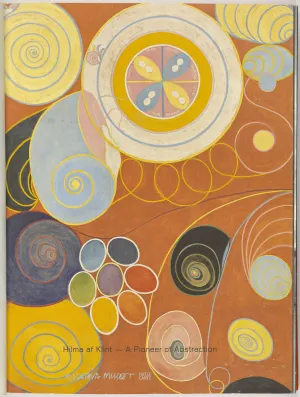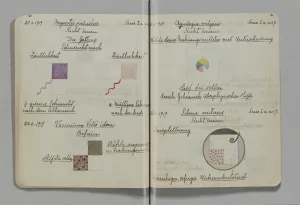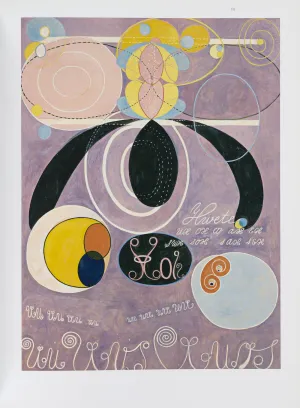Hilma af Klint: Beyond "Beyond the Visible"
March 9, 2021
By Cori Edmonds-Hutchinson, Interlibrary Loan Assistant
Perhaps unexpectedly, the Frick Art Reference Library holds art historical materials beyond the scope of the Frick’s permanent collection, offering a multitude of books, reference titles, and archival photographs related to Western art from the fourth to the mid-twentieth century. These materials include extensive holdings on modernism, which I was moved to consult after viewing the documentary Beyond the Visible: Hilma af Klint, released in the United States in April 2020 by Zeitgeist Films in association with Kino Lorber. The documentary, directed by Halina Dyrschka, endeavors to situate the secluded life of the Swedish abstractionist into a more robust history as well as to encourage further research within the realms of the painter’s biography, archive, and relations.
The Frick Art Reference Library catalog enables this approach, as it holds a significant collection of printed material related to af Klint. Titles held in the library include Hilma af Klint: Paintings for the Future, which accompanied the 2018–19 Guggenheim Museum exhibition of the same name, and Hilma af Klint: Notes and Methods, the first extensive English translation of the writings and glossary of cryptolect integrated by af Klint into her works of art. For a more comprehensive biography of the artist, Hilma af Klint: A Pioneer of Abstraction can be consulted.
In the essay “Spiritual Alphabetisation” within Hilma af Klint: The Art of Seeing the Invisible, Hanne Loreck writes of the “educational eros” of af Klint, whose work “organizes a certain knowledge including uncertainties.” Af Klint’s personal library of esoteric literature, inventoried by the Hilma af Klint Foundation, sought to do the same. She belonged to many schools, both informal and established, including the Spiritualist Literature Association as a late teen, where she first participated in séances; the Royal Academy of Fine Arts in Stockholm; the Swedish Theosophical Society; the Anthroposophical Society; the Edelweiss Society; and “The Friday Group,” or “The Five,” wherein she made routine her commitment to spiritual practice and mediumship alongside four other women. Thus, af Klint’s lifelong organization of knowledge and contact occurred mostly in intimate communities and, in the case of “The Five,” in sisterhoods.
Hilma af Klint donated a set of now-lost fundamental botanical studies to the scientific library in Dornach, Switzerland, in 1927. A complete facsimile of the notebook Flowers, Mosses and Lichen can be found at the Frick in both The Legacy of Hilma af Klint: Nine Contemporary Responses and Hilma af Klint: Notes and Methods. In these studies, af Klint combines scientific language and diagrams with expressive colors and perceived qualities of each plant, developing a unique classification system.
The Hilma af Klint: Paintings for the Future catalog notes that in addition to observed natural forms, af Klint translates images from print culture, such as scientific texts and medieval manuscripts, into “wild, huge paintings.” The aforementioned documentary offers a true-to-scale demonstration of the artist’s series The Ten Largest by an af Klint impersonator who recreates each painting on the floor, planar and enormous. The unconventional method, medium (paper pasted on canvas), and urgency (approximately four days per painting) implemented by af Klint to produce this 1907 series foregrounds their material significance. The paintings from this series, among others, are surveyed in the catalog held by the Frick Art Reference Library.
Another miraculous aspect of Hilma af Klint’s legacy expanded upon in the items found in the library’s collections is the survival of the artist’s vast archives, which were previously stored in wooden crates under extreme climate conditions by Erik af Klint, nephew and direct heir of the estate. Now under the stewardship of Johan af Klint, Hilma af Klint’s grandnephew, over 1,500 paintings and 26,000 pages of books benefit from more guided preservation techniques that remain in compliance with the register typed in 1945 by af Klint’s secretary, Olof Sundström, and guidelines set by af Klint herself, including that the artworks should only be exposed twenty years after her death and must never be sold. Though not directly part of it, the Frick Art Reference Library’s holdings on af Klint’s life and legacy serve as an extension of the private archive she left behind.
Shortly after the release of the film, a single watercolor titled Fiery Flames (Eldslågor) (1930) by Hilma af Klint appeared at auction in Sweden. This work, in rare market circulation, was gifted by af Klint herself to sisters and textile artists Elsa and Magda Jerud and therefore falls beyond the will of the Foundation. Artnet, one of many databases available onsite to library users, provides further information on this work’s provenance.
While af Klint’s paintings are not presently lodged in the spiral temple she envisioned, we benefit as students and admirers from access to her work in the form of its circulating, physical presence and through print and film media. The Frick Art Reference Library enables this second type of access to art history, here offering researchers and art lovers a gateway to af Klint, a previously unsung pioneer of abstraction and modernism. Belief in her principles would suggest that she can serve as a guide even through spirit, which lives on, in part, in the materials in our collections.
The Frick Art Reference Library’s reading room at Frick Madison opens to the public by appointment only on Tuesday, March 23, 2021. Learn more at frick.org/visit/library.
Transcript
[Left-hand page]
30
20.6.1919
Serie I a n° [number not pictured]
Myosotis palustris
Richt linien:
Die Gattung
Sehnsucht nach
Zärtlichkeit
[Left-hand diagram of a four-square grid. The top right square is colored a bluish purple. The bottom left square has a pink wavy diagonal line from bottom left to top right.]
b grössere Sehnsucht
nach dem Ätherreich
Zärtlichkeit
[Right-hand diagram of a four-square grid. The top right square is colored in light pink. The bottom left square has a red wavy diagonal line from bottom left to top right.]
a kräftigere Sehnsucht
nach der Erde.
20.6.1919
Vaccinium Vitis idaea
Befreier
[Centered diagram of a four-square grid. The top right square is colored in a mottled gold and labeled “Wähle angemessene Nahrungsmittel.” The bottom left square, colored gold with a pink crooked line and black and white dots, is labeled “Hilf dir selber”.]
[Right-hand page]
31
21.6.1919
Serie I a n°7
Aquilegia vulgaris
Richt linien:
Wähle deine Nahrungsmitteln mit Unterscheidung.
[Centered diagram of a four-square grid, with a small circle inscribed in the center. Within each of the four squares, the quarter-circle is halved. Each resulting eighth slice of the circle is colored in, from bottom left: pink and dark blue, dark blue and yellow, yellow and light blue, light blue and no color.]
Hilf dir selber
durch Gebrauch überphysicher Hilfe.
23.6.1919
Serie I a n°7
Silene nutans
Richt linien:
Zersplitterung
[Centered diagram of a circle overlaid with two dotted, intersecting squares, a brown spiral connecting them. Two arrows at bottom right point in opposite directions. A four-square grid is inscribed in the circle, its bottom left square colored a light gray with red dots. The semicircles between the inscribed square and the surrounding circle are colored, clockwise from top, black, light blue, light green, and pale gray.]
Unruhiger, eifriger Wirksamksitstrieb.



